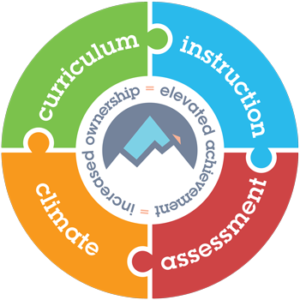Share this article.
We all know that the purpose of education is to make sure that each and every student attains the highest level of achievement each and every day. This means that each and every teacher must provide support for attaining the highest level of achievement each and every day. This, in turn, means that the principal’s job is to support the teachers to provide and the students to attain—at the highest levels each and every day.
You are probably asking, how does a principal do that? A principal does that by utilizing the actions of instructional leadership—you, as the principal, determine the goals of an initiative focused on student achievement and you lead its implementation with all stakeholders.
But, how will you know when it’s working? The skill of instructional leadership is made up of actions that can be seen and heard. Talk to your teachers and staff. Ask them questions about their role in implementing the initiative. Listen to their answers.
What you are listening for is understanding from your teachers about the goals of the initiative. What you are listening for is articulations from your teachers about how they will be supported. What you are listening for is explanations from your teachers about what success looks like. What you are listening for is sharing from your teachers about how they are working together.
Here are some examples of what you should hear if you are effectively utilizing the actions of instructional leadership.
What a high school chemistry teacher said, when supported by instructional leadership, to incorporate distance learning into instruction…
“We have been told time and time again that our students should know the objective of every lesson. They should know what specific skill they are learning and how they will demonstrate that they have learned it. But when it came to our learning, we never received this before. Now we do. For every professional development session on distance learning, we are told exactly what we are expected to learn and how we will know we have learned it. We are told how the session connects to the big picture of our school goals. That clarity has been so supportive. And this has helped those of us who are still a bit uncomfortable using so much technology.”
What a sixth-grade teacher said, when supported by instructional leadership, to develop student ownership across the school…
“I am so appreciative of how our principal shares information regarding student ownership with us. With prior administrators, we were basically just told to show up and do this and do that. We never really knew why we were doing things and we never knew what was expected from us. With this initiative on student ownership, our principal shares with us the focus for the year, why this is our focus, what is expected from me, and what is the plan. He also tells us what we can expect from him. That way, it feels like we are a collective ‘We,’ not just individual ‘I’s.”
What an eighth-grade Earth science teacher said, when supported by instructional leadership, to implement new science textbooks…
“We got a new textbook program this year. Last year we built a scope and sequence from the new science standards. This year our initiative is to implement the new textbook program following our scope and sequence. There are a lot of print and online resources that the program comes with. In previous new textbook adoptions, we usually attended a district-provided full-day training session on the program. These days were overwhelming and many of us would leave uncertain how to use the materials. This time our principal worked with us to develop a plan that would give us support throughout the year. We started with an overview of the program. From there we will have shorter sessions that focus on a particular component of the program. We then are provided with planning time to decide how we could incorporate that component into our instruction. Giving us the year to really understand the materials and ongoing support has made all of the difference.”
What a tenth-grade English language arts teacher said, when supported by instructional leadership, to implement a new data protocol process…
“We are implementing a data protocol process. As an ELA department, we are analyzing student writing samples from each unit and our quarterly benchmark assessments. This process will allow us to not just look at the data but to analyze the instructional decisions we made that impacted the data so we can replicate strong practices and rectify areas of need. As we reviewed the plan of support for the year with the principal, we noticed that there were going to be additional needs. The plan did not include training on scoring writing. We need this if we were to be calibrated. It did not include the time needed to score writing. It included our grade-level PLC time, but we felt we needed to have department PLC time as well so we could have vertical conversations on student performance. Thankfully, we saw the plan at the onset and were able to share these needs with the principal. She had not budgeted for this, but she was able to move money around so that we could have the best plan possible to successfully implement our initiative.”
What an eleventh-grade government teacher said, when supported by instructional leadership, to develop a social sciences course scope and sequence…
“We recently developed a standards-based scope and sequence for our courses. It allowed us to plan the entire year and develop meaningful unit prompts so students could demonstrate their collective learning. I felt confident going into the first unit. My assistant principal did an observation of one of my lessons and was asking me some good questions about my lesson and how it was tied to the unit outcome. I struggled to articulate the connections and realized they were not there. And if they weren’t there for me, they certainly were not there for my students. The conversation helped me realize that I needed to revisit the unit plan and make certain I could see how it all connected.”
What a third-grade teacher said, when supported by instructional leadership, to teach through distance learning…
“We are implementing a learning management system to allow for distance learning. I am not comfortable with technology. Our principal is not either. Our principal decided that he needed to learn along with us. He has set up our staff as his classroom. He has created all of the communication and the plan for our initiative in this classroom. He even did some online lessons on the LMS with us so we could see the experience from the student perspective. But more importantly, he has shared with us every frustration and success he has had along the way. Seeing him willing to learn and take risks, and honestly fail at times, has made it easier for me to do the same. It reminds me that we are all learners and that we are in this together.”
Our Support for You
We, at Elevated Achievement, want to support you in building your dream school. That’s why this article is part of a series of articles that show current principals, assistant principals, and future administrators how to turn your dream into your reality by developing the actions of instructional leadership in curriculum, instruction, assessment, and climate and empowering your teachers to elevate student achievement.
So, keep reading. See what administrators are saying about instructional leadership. Keep learning. Discover how one administrator used instructional leadership to implement an initiative to elevate student achievement. Together, we can increase our impact in ways that benefits each and every student.
Continue the Learning
Check out these articles and resources to continue your learning about this topic…
The Learning Brief
In this article you learned…
- How a principal can utilize the actions of instructional leadership to support their teachers to provide and the students to attain—at the highest levels of achievement each and every day.
- How to know the actions of instructional leadership are effective by listening for understanding about the goals of the initiative, articulations about how teachers will be supported, explanations about what success looks like and sharing about how teachers are working together.
- That you are not alone in this endeavor and can find additional support for developing instructional leadership from us. (elevatedachievement.com)


